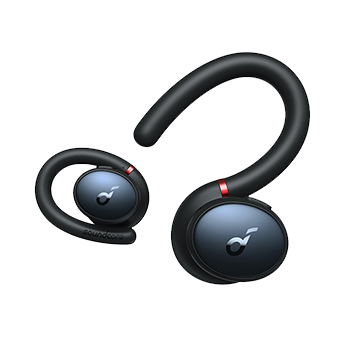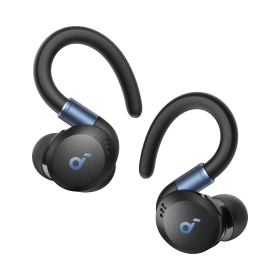Bone Conduction Headphones vs Earbuds: Which to Choose?
Earbuds and bone-conduction headphones are two of the most popular audio devices on the market today. Most people know about earbuds since they are all the rage these days. There's even a good chance that you own a pair yourself. People love them because they are portable and less intrusive than traditional wired earphones. On the other hand, most bone-conduction headphones are marketed for athletes and people with hearing disabilities. But are bone conduction headphones good for everyday use, much like earbuds? Let's find out.

Bone Conduction Headphones vs Earbuds: What Are the Differences?
Bone conduction headphones and earbuds have the same function of letting you listen to audio coming from your phone or other Bluetooth-enabled devices. However, they do it differently based on which part of the ear they use to deliver the sound.
One of the standout features of bone-conduction headphones is how they deliver sound. Instead of blasting tunes directly into your ears, they use bone conduction technology to transmit vibrations to the inner ear through your cheekbones. Thus, it leaves your ear canals free for an open-ear experience.
Meanwhile, earbuds use the more traditional approach of directly delivering the sounds through the ear canal. The speakers from in-ear earbuds generate sound waves that travel through the air and are received by your eardrums.
So, are bone-conduction headphones better than earbuds? For some people, it's a definite yes. After all, it puts less pressure on the eardrums and reduces the risk of long-term issues.
Bone Conduction Headphones Pros and Cons
It's essential to know the difference between bone conduction vs earbuds if you want to pick the best type of audio device. After all, both offer different listening experiences regarding comfort, safety, and even audio quality. Is bone conduction headphones good at all? Let's delve deeper into its pros and cons.
Pros of Bone Conduction Headphones
Now that you know how these two audio devices work, are bone conduction headphones better for your ears? Let's look into its benefits and advantages:
- Bone conduction headphones promote situational awareness, which is crucial for running outside and other activities.
- They are less likely to damage your hearing than traditional headphones and earbuds, where sound travels through the ear canal.
- You can wear them for long periods. You can also use them to make calls or listen to music from your computer or paired devices.
- It works well with users who don't want excessive noise levels
- These open-ear headphonesare fabulous for hearing-impaired persons with deficiencies in their ear canal.
Cons of Bone Conduction Headphones
There's a vast difference between bone conduction headphones vs normal headphones. The former has a band around the back of the head, while the latter has one on top. Because of this design, bone conduction headphones have these few disadvantages:
- Bone conduction headphones aren't comfortable, especially for people with glasses or long hair.
- They also have subpar sound quality because of their lower volume and bass.
- Some headphone models sometimes generate unpleasant buzzing caused by sound vibrations.
In-Ear Earbuds Pros and Cons
Earbuds offer a unique audio experience you won't get from bone-conduction headphones. But, to determine whether bone conduction headphones vs earbuds are better, we must also consider their advantages and disadvantages.
Pros of In-Ear Earbuds
In-ear earbuds are much better than their earlier versions because you won't have to worry about the wires getting tangled. Below are other pros of this audio device:
- It has immersive sound quality that's great when gaming or watching movies.
- In-ear earbuds have noise-canceling properties that block other sounds from reaching your ear canal. Hence, they are great when focusing on a call or the audio.
- They are more ergonomic and portable, making them great for constantly traveling.
- Premium models offer audiophile-quality music that you won't get from bone-conduction headphones.
- They are more affordable than other kinds of headphones.
Cons of In-Ear Earbuds
While in-ear earbuds are great for any application, there are instances when they are not the best choice. If you are cycling or running on the road and must know the sounds around you, you are better off with bone-conduction headphones. Here are other cons of in-ear earbuds:
- They are more likely to affect your hearing because most users are often tempted to increase the volume.
- While they have a snug fit, there's a slight chance they fall off and get damaged by the incident.
- Not all models come with swappable earbud tips for different-shaped ears. Plus, they can sometimes be uncomfortable, especially when worn for long periods.
Best In-Ear Earbuds
Now that you are all caught up with in-ear earbuds' features, advantages, and disadvantages, let's get into the best model.
While there are many options, we must consider in-ear earbuds that deliver the best performance, offer quality-of-life features, and have the best value for your money. For these reasons, we chose the soundcore Liberty 4 Pro.
Liberty 4 Pro

The soundcore Liberty 4 Pro impresses with its cutting-edge noise cancelling capability. These best in-ear noise cancelling earbuds constantly adjust to your surroundings, thanks to their Adaptive Noise Cancelling (ANC) 3.0 technology that tweaks the noise cancellation curve every 1/3 second. Plus with six sound sensors and an air pressure sensor, whether you're in a bustling café or a quiet park, you'll enjoy an immersive listening experience.
For audiophiles, the Liberty 4 Pro delivers a truly refined audio experience. Its ACAA 4.0 dual-driver acoustic architecture, featuring upgraded 10.5mm bass and 4.6mm high-frequency drivers, creates a sound that’s both rich and detailed, with crisp highs and deep lows. The digital crossover technology takes this further, making every note clear and distinct.
Managing your audio settings is effortless with the Liberty 4 Pro’s intuitive case touch bar and smart display. Switching between noise cancellation and transparency modes or adjusting ambient sound is as easy as a tap, giving you seamless control over your listening experience, no matter where you are.
Best Bone Conduction Headphones
Bone conduction headphones are safer than earbuds. If you are looking for a pair, then, the H2O Audio Multi-Sport is a good choice. This device has one of the highest waterproof ratings in the category at IPX8. You can submerge it in three meters of water for 30 minutes, which will be fine.
H2O Audio Multi-Sport
The H2O bone conduction headphones have a built-in MP3 player with 8 GB of memory. Hence, you won't have to rely on Bluetooth connectivity to play your favorite tracks. And the best part? You can even listen to music while swimming or doing most water sports.
Furthermore, its sound quality is better than most bone-conduction headphones. It also has a battery life of over eight hours and weighs only 33 grams.
Conclusion
Both bone-conduction headphones and in-ear earbuds offer something different to their users. The former is marketed towards athletes and outdoorsy people. Meanwhile, in-ear earbuds work best for people who like to listen to music in more secure surroundings. Whichever device you choose, it's essential to consider the price and features and where you will use the listening device more often.





























































